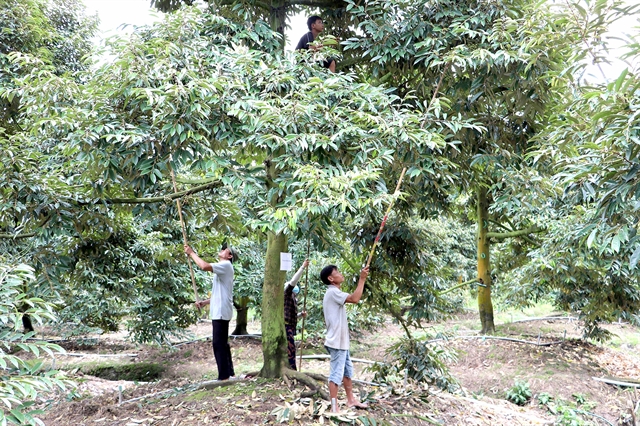 Society
Society

 |
| Farmers tend durian trees in Tiền Giang Province. — VNA/VNS Photo Minh Trí |
TIỀN GIANG — The Cửu Long (Mekong) Delta of Tiền Giang is developing concentrated fruit growing areas to improve fruit quality and value.
The country’s largest fruit growing locality has more than 86,000ha of fruits, up 3.4 per cent from last year, according to its Department of Agriculture and Rural Development.
Tiền Giang grows various kinds of fruits such as Chợ Gạo dragon fruit, Ngũ Hiệp durian, Hoà Lộc mango and Vĩnh Kim milk apple, and these fruits have competitive advantages in domestic and foreign markets.
Nguyễn Văn Mẫn, director of the provincial agriculture department, said the province had developed concentrated growing areas for 9,000ha of dragon fruit, more than 20,000ha of durian and nearly 15,400ha of pineapple.
These concentrated growing areas have high economic value and are the province’s most important export products, according to Mẫn.
Concentrated fruit growing areas are developed with the natural conditions of each locality to serve domestic and foreign markets.
In saltwater affected areas in the province’s eastern region and in the Đồng Tháp Mười (Plain of Reeds) region, the province has encouraged farmers to grow dragon fruit and pineapple as they can grow well in these areas.
In fresh water areas along the Tiền River, a tributary of the Mekong River, farmers are encouraged to grow milk apple, sapodilla, green-skin and pink-flesh grape fruit.
In flood-controlled areas in the province’s eastern region, the province develops durian, Hoà Lộc mango and citrus fruits.
The department, in co-operation with districts and towns, has provided farmers with advanced techniques and encouraged them to apply the techniques, such as intensive farming under Vietnamese and global good agricultural practices standards and producing off-season fruits.
It has encouraged farmers to produce off-season fruits to avoid oversupply during the peak harvest season and price declines.
The province has developed more cooperatives and cooperative groups to gather farmers together for large-scale production, and strengthened trade promotion activities for agricultural produce.
It has boosted managing and granting production codes for fruit growing areas and establishments that pack fruits for export.
The province has 297 fruit growing areas with a total of 20,300ha, mostly growing dragon fruit, durian and milk apple, that have been granted production codes.
It also has 307 packaging establishments that have been granted production codes for exporting.
To increase fruit quality to meet market requirements, the province targets all concentrated fruit growing areas that grow specialty fruits to be granted production codes for exporting by 2025.
Some specialty fruits such as Chợ Gạo dragon fruit, Hoà Lộc mango and Ngũ Hiệp durian have been granted geographical indication by the National Office of Intellectual Property, and this created a favourable condition to promote brand names of the province’s specialty fruits.
The province has 190 cooperatives operating in the agriculture and seafood sectors, including 30 durian growing cooperatives with a total of 18,900 members and 18 dragon fruit growing cooperatives with a total of 2,236 members.
This year, prices of the province’s key fruits are high, and this helps farmers in concentrated fruit growing areas to have stable incomes and lives, according to the department.
Many farmers have become wealthy because they had bumper harvests and high prices.
Concentrated fruit growing areas have begun harvesting off-season fruits and the price of durian, dragon fruit and pineapples are increasing.
Huỳnh Tấn Lộc, director of the Ngũ Hiệp Durian Cooperative in Cai Lậy District, said traders buy Mon Thong durian at a price of VNĐ110,000-130,000 (US$4.5-5.4) a kilogramme and Ri 6 durian at a price of VNĐ100,000-110,000 ($4.1-4.5) a kilogramme, up VNĐ24,000-30,000 ($1-1.2) from one month ago.
In Cai Lậy, Long Trung Commune has nearly 1,000ha of concentrated durian growing area with an annual output of 20,000-30,000 tonnes.
Dương Phước Hưng, Chairman of the Long Trung Commune People’s Committee, said the price of off-season durian at the beginning of the harvest season increased significantly and farmers earned high profits.
With an average yield of 20-24 tonnes per hectare and high selling prices, farmers earned a profit of VNĐ1 billion ($41,300) a hectare, the highest profit compared to growing other specialty fruits, he said.
In Chợ Gạo District, which has the largest dragon fruit growing area in the province, traders bought the fruit at a price of VNĐ10,000-28,000 (41 US cents - $1.2) a kilogramme depending on fruit quality and size, up two to three times against the same period last year.
In Tân Phước District, traders bought pineapples at a price of VNĐ8,000-9,000 (32-37 US cents) a kilogramme this year, up nearly double from last year.
Trần Hoàng Phong, Chairman of the Tân Phước District People’s Committee, said that with this price, farmers earned a profit of VNĐ100 million ($4,100) per hectare a year.
Thanks to high income from growing pineapple, people in Tân Phước had overcome difficulties, escaped poverty and had stable lives, he said.
The province harvested 1.32 million tonnes of fruits in the first 11 months of the year, an increase of 2.4 per cent year-on-year.
It is entering the peak fruit harvest season from now to the Tết (Lunar New Year) festival, which falls in February next year. — VNS